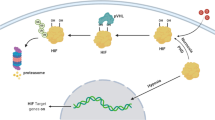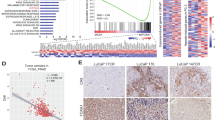Abstract
Purpose
The hypoxic tumor microenvironment and the maintenance of stem cells are relevant to the malignancy of prostate cancer (PCa). However, whether HIF-1α in the hypoxic microenvironment mediates the transformation of prostate cancer to a stem cell phenotype and the mechanism have not been elucidated.
Materials and methods
Prostate cancer stem cells (PCSCs) from PC-3 cell lines were examined for the expression of CD44, CD133, ALDH1, HIF-1α, Notch1, and HES1. We observed the effect of knockdown HIF-1α in vitro and mice models and evaluated the impact of HIF-1α on the Notch1 pathway as well as stem cell dedifferentiation. The effects on sphere formation, cell proliferation, apoptosis, cell cycle, and invasive metastasis were evaluated.
Results
In our study, hypoxia upregulated HIF-1α expression and induced a stem cell phenotype through activation of the Notch1 pathway, leading to enhanced proliferation, invasion, and migration of PCa PC-3 cells. The knockdown of HIF-1α significantly inhibited cell dedifferentiation and the ability to proliferate, invade and metastasize. However, the inhibitory effect of knocking down HIF-1α was reversed by Jagged1, an activator of the Notch1 pathway. These findings were further confirmed in vivo, where hypoxia could enhance the tumorigenicity of xenograft tumors by upregulating the expression of HIF-1α to activate the Notch1 pathway. In addition, the expression of HIF-1α and Notch1 was significantly increased in human PCa tissues, and high expression of HIF-1α correlated with the malignancy of PCa.
Conclusion
In a hypoxic environment, HIF-1α promotes PCa cell dedifferentiation to stem-like cell phenotypes by activating the Notch1 pathway and enhancing the proliferation and invasive capacity of PC-3 cells.








Similar content being viewed by others
Data availability
The datasets generated during and/or analyzed during the current study are available from the corresponding author on reasonable request.
References
Valle S, Sharifi N. Targeting Glucocorticoid Metabolism in Prostate Cancer. Endocrinology. 2021;162.
Qiu H, Cao S, Xu R. Cancer incidence, mortality, and burden in China: a time-trend analysis and comparison with the United States and United Kingdom based on the global epidemiological data released in 2020. Cancer Commun (Lond). 2021;41:1037–48.
Netto GJ, Amin MB, Berney DM, Comperat EM, Gill AJ, Hartmann A, et al. The 2022 World health organization classification of tumors of the urinary system and male genital organs-part b: prostate and urinary tract tumors. Eur Urol. 2022;82:469–82.
Adamaki M, Zoumpourlis V. Prostate cancer biomarkers: from diagnosis to prognosis and precision-guided therapeutics. Pharmacol Ther. 2021;228: 107932.
Parker C, Castro E, Fizazi K, Heidenreich A, Ost P, Procopio G, et al. Prostate cancer: ESMO clinical practice guidelines for diagnosis, treatment and follow-up. Ann Oncol. 2020;31:1119–34.
Wolf I, Gratzke C, Wolf P. Prostate cancer stem cells: clinical aspects and targeted therapies. Front Oncol. 2022;12: 935715.
Di Zazzo E, Galasso G, Giovannelli P, Di Donato M, Di Santi A, Cernera G, et al. Prostate cancer stem cells: the role of androgen and estrogen receptors. Oncotarget. 2016;7:193–208.
Hasan D, Gamen E, Abu Tarboush N, Ismail Y, Pak O, Azab B. PKM2 and HIF-1alpha regulation in prostate cancer cell lines. PLoS ONE. 2018;13: e0203745.
Xia L, Sun J, Xie S, Chi C, Zhu Y, Pan J, et al. PRKAR2B-HIF-1alpha loop promotes aerobic glycolysis and tumour growth in prostate cancer. Cell Prolif. 2020;53: e12918.
Tran MGB, Bibby BAS, Yang L, Lo F, Warren AY, Shukla D, et al. Independence of HIF1a and androgen signaling pathways in prostate cancer. BMC Cancer. 2020;20:469.
Huang M, Du H, Zhang L, Che H, Liang C. The association of HIF-1alpha expression with clinicopathological significance in prostate cancer: a meta-analysis. Cancer Manag Res. 2018;10:2809–16.
Semenza GL. Dynamic regulation of stem cell specification and maintenance by hypoxia-inducible factors. Mol Aspects Med. 2016;47–48:15–23.
Wang L, Zi H, Luo Y, Liu T, Zheng H, Xie C, et al. Inhibition of Notch pathway enhances the anti-tumor effect of docetaxel in prostate cancer stem-like cells. Stem Cell Res Ther. 2020;11:258.
Cheng JW, Duan LX, Yu Y, Wang P, Feng JL, Feng GZ, et al. Bone marrow mesenchymal stem cells promote prostate cancer cell stemness via cell-cell contact to activate the Jagged1/Notch1 pathway. Cell Biosci. 2021;11:87.
Jamal A, Khan T, Zaidi U, Rizvi QA, Jahanzeb S, Salim A, et al. Highly specific functional equivalence of XN-HPC for optimum CD34+ cell count in harvested allogeneic bone marrow stem cell products. Hematology. 2022;27:232–8.
Marhold M, Tomasich E, El-Gazzar A, Heller G, Spittler A, Horvat R, et al. HIF1alpha regulates mTOR signaling and viability of prostate cancer stem cells. Mol Cancer Res. 2015;13:556–64.
Xiang L, Semenza GL. Hypoxia-inducible factors promote breast cancer stem cell specification and maintenance in response to hypoxia or cytotoxic chemotherapy. Adv Cancer Res. 2019;141:175–212.
Hajizadeh F, Okoye I, Esmaily M, Ghasemi Chaleshtari M, Masjedi A, Azizi G, et al. Hypoxia inducible factors in the tumor microenvironment as therapeutic targets of cancer stem cells. Life Sci. 2019;237: 116952.
Sun X, Lv X, Yan Y, Zhao Y, Ma R, He M, et al. Hypoxia-mediated cancer stem cell resistance and targeted therapy. Biomed Pharmacother. 2020;130: 110623.
Rey S, Schito L, Wouters BG, Eliasof S, Kerbel RS. Targeting hypoxia-inducible factors for antiangiogenic cancer therapy. Trends Cancer. 2017;3:529–41.
O’Reilly D, Johnson P, Buchanan PJ. Hypoxia induced cancer stem cell enrichment promotes resistance to androgen deprivation therapy in prostate cancer. Steroids. 2019;152: 108497.
Yang L, Shi P, Zhao G, Xu J, Peng W, Zhang J, et al. Targeting cancer stem cell pathways for cancer therapy. Signal Transduct Target Ther. 2020;5:8.
Semenza GL. Hypoxia-inducible factors: coupling glucose metabolism and redox regulation with induction of the breast cancer stem cell phenotype. EMBO J. 2017;36:252–9.
Boyd NH, Tran AN, Bernstock JD, Etminan T, Jones AB, Gillespie GY, et al. Glioma stem cells and their roles within the hypoxic tumor microenvironment. Theranostics. 2021;11:665–83.
Hao S, Zhu X, Liu Z, Wu X, Li S, Jiang P, et al. Chronic intermittent hypoxia promoted lung cancer stem cell-like properties via enhancing Bach1 expression. Respir Res. 2021;22:58.
Rainho MA, Mencalha AL, Thole AA. Hypoxia effects on cancer stem cell phenotype in colorectal cancer: a mini-review. Mol Biol Rep. 2021;48:7527–35.
Keith B, Johnson RS, Simon MC. HIF1alpha and HIF2alpha: sibling rivalry in hypoxic tumour growth and progression. Nat Rev Cancer. 2011;12:9–22.
Zhang M, Zhang Y, Ding Y, Huang J, Yao J, Xie Z, et al. Regulating the Expression of HIF-1alpha or lncRNA: Potential Directions for Cancer Therapy. Cells. 2022;11.
Peng G, Liu Y. Hypoxia-inducible factors in cancer stem cells and inflammation. Trends Pharmacol Sci. 2015;36:374–83.
Kheshtchin N, Arab S, Ajami M, Mirzaei R, Ashourpour M, Mousavi N, et al. Inhibition of HIF-1alpha enhances anti-tumor effects of dendritic cell-based vaccination in a mouse model of breast cancer. Cancer Immunol Immunother. 2016;65:1159–67.
Vieira Pde B, Giordani RB, Macedo AJ, Tasca T. Natural and synthetic compound anti-Trichomonas vaginalis: an update review. Parasitol Res. 2015;114:1249–61.
Miyazawa K, Tanaka T, Nakai D, Morita N, Suzuki K. Immunohistochemical expression of four different stem cell markers in prostate cancer: High expression of NANOG in conjunction with hypoxia-inducible factor-1alpha expression is involved in prostate epithelial malignancy. Oncol Lett. 2014;8:985–92.
Venkatesh V, Nataraj R, Thangaraj GS, Karthikeyan M, Gnanasekaran A, Kaginelli SB, et al. Targeting Notch signalling pathway of cancer stem cells. Stem Cell Investig. 2018;5:5.
Teoh SL, Das S. Notch signalling pathways and their importance in the treatment of cancers. Curr Drug Targets. 2018;19:128–43.
Mu R, Zou YK, Tu K, Wang DB, Tang D, Yu Z, et al. Hypoxia promotes pancreatic cancer cell dedifferentiation to stem-like cell phenotypes with high tumorigenic potential by the HIF-1alpha/Notch signaling pathway. Pancreas. 2021;50:756–65.
Byun JY, Huang K, Lee JS, Huang W, Hu L, Zheng X, et al. Targeting HIF-1alpha/NOTCH1 pathway eliminates CD44(+) cancer stem-like cell phenotypes, malignancy, and resistance to therapy in head and neck squamous cell carcinoma. Oncogene. 2022;41:1352–63.
Funding
This work was supported by the Chongqing medical scientific research project (Joint project of Chongqing Health Commission and Science and Technology Bureau) (Grant No. 2019ZY023447).
Author information
Authors and Affiliations
Contributions
KW and HZ conceived the study design and designed the experiments. KW, MW and HY acquired, analyzed, interpreted the data, and drafted the manuscript. RD and HZ reviewed the manuscript and provided comments. All the authors read and approved the final manuscript and agree to be accountable for all aspects of the work.
Corresponding author
Ethics declarations
Conflict of interest
The authors have no relevant financial or non-financial interests to disclose.
Ethical approval
This study was performed in line with the principles of the Declaration of Helsinki. All procedures related to the use and care of animals in this study were approved by the ethics committee of Chongqing Jiangjin District Hospital of Chinese Medicine.
Informed consent
Informed consent was obtained from all individual participants included in the study.
Additional information
Publisher's Note
Springer Nature remains neutral with regard to jurisdictional claims in published maps and institutional affiliations.
Rights and permissions
Springer Nature or its licensor (e.g. a society or other partner) holds exclusive rights to this article under a publishing agreement with the author(s) or other rightsholder(s); author self-archiving of the accepted manuscript version of this article is solely governed by the terms of such publishing agreement and applicable law.
About this article
Cite this article
Wu, K., Wu, M., Yang, H. et al. Hypoxia promotes conversion to a stem cell phenotype in prostate cancer cells by activating HIF-1α/Notch1 signaling pathway. Clin Transl Oncol 25, 2138–2152 (2023). https://doi.org/10.1007/s12094-023-03093-w
Received:
Accepted:
Published:
Issue Date:
DOI: https://doi.org/10.1007/s12094-023-03093-w




